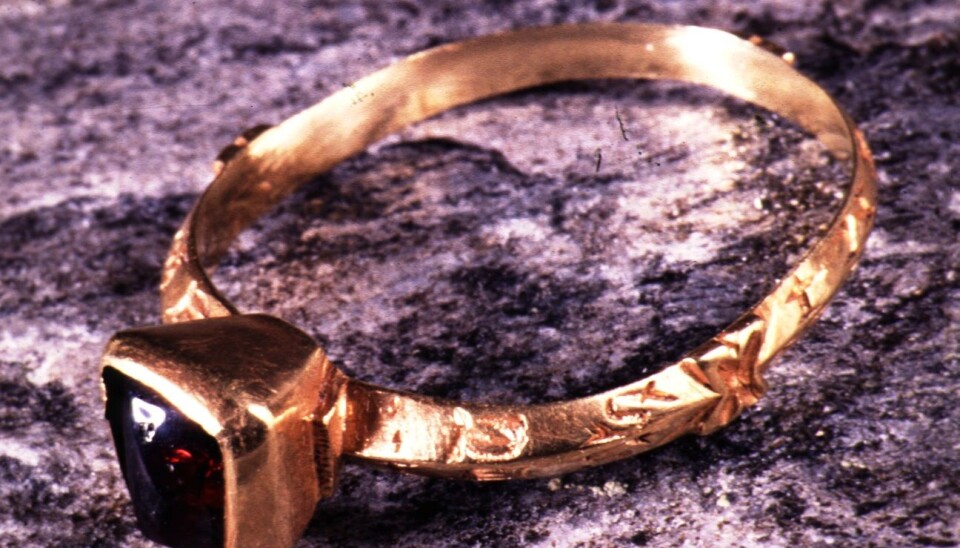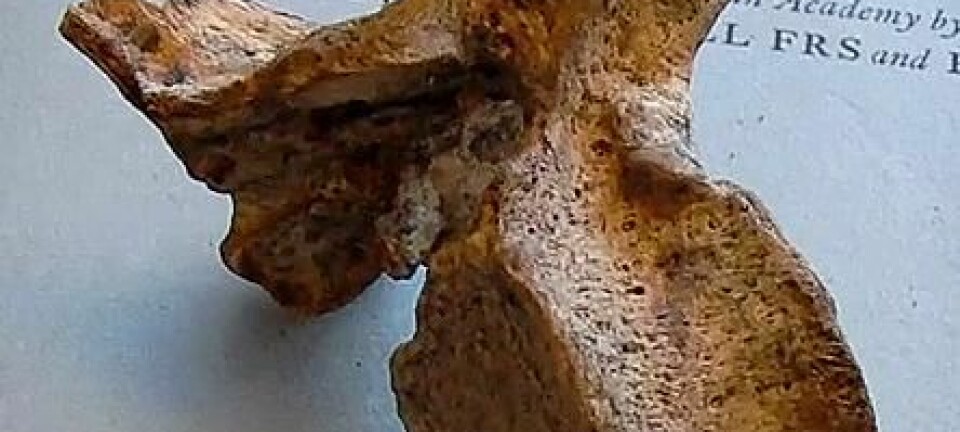
Who gave this ring to her lover?
Archaeologist Brit Solli has been speculating for 20 years what a gold ring from the 13th century has been doing inside a stone wall on a small Norwegian island.
Denne artikkelen er over ti år gammel og kan inneholde utdatert informasjon.
It was Midsummer Day in 1990 when Brit Solli found the ring. She had a scholarship to work on her doctorate and was digging in an old wall at the small island Veøya on the west coast of Norway.
At first she suspected that some teenagers fooling around the evening before had placed a piece of costume jewellery there, because they had joked about pulling a gag on the young archaeologist.
But the ring turned out to be genuine. It was gold with a red garnet; moreover it was 800 years old and had a French inscription along the outside reading:
Eric between friends, and I am a devoted mistress. A.M.

Courtly gift of love?
“What kind of ring is this? Is it an engagement ring or something else? And who was the lady who gave it to Eric, and what had he done to deserve such a token of devotion?” queries Solli.
She thinks we have to look to medieval knighthood traditions and the old rituals of honour and chivalric love – the close, non-marital relations between a noblewoman and her young admirers, in order to understand the meaning of the ring.
Chivalry was a custom that evolved on Continental Europe in the 1100s. In the course of time knighthood literature in the form of ballades and tales were translated to Norwegian and became a source of inspiration in Norway too.
Eric between friends, and I am a devoted mistress. A.M.
This was primarily a fad of the nobility – it was the upper class that adopted cultural trends of the European elite. An item like the ring that Brit Solli found in a wall would be a common gift from a woman to a man in accordance with the chivalric customs of courtly love.
“Courtly love was in many ways a matter of ritual and it was supposed to follow four stages. An important rule was that the relationship was to be kept secret. When a male suitor or admirer was accepted, he could receive a ring from an often older noblewoman,” says Solli.
Guessing what happened
She hasn’t been able to determine where the ring was made. It could have come from elsewhere in Europe but there were also goldsmiths in Norway who could have managed the task, she says.
The ring is slightly worn so it was probably used for a while before someone decided to hide it in the wall.
“That’s where the facts stop and conjecture starts,” says Solli.
An important question is: Why should such a concrete trace of the customs of Continental chivalry be found at this small island so far north?
Solli has pieced together her own possible explanations, based on historical facts from the area.
Possibiltiy 1:
The ring can have been given by a noblewoman to her lover as a token of appreciation because her husband was often absent. She gave it to him one evening when they met, Solli imagines.
The two were interrupted by clamour from the harbour – the faction known as the Baglers in the ongoing civil war had attacked and Eric had to run off and help, but didn’t want to wear the ring in battle – so he hid it in the wall.
Many were killed and after that evening nobody knew about the ring. So it remained there for 800 years until a young archaeologist caught its sparkle in the sunlight.
In the Bagler tale of the sagas of the Norwegian kings it was said that the Baglers raided a town at Veøy in 1206, and there were several battles between them and the other faction, the Birkebeiners, around the turn of the century, points out Solli.
But she has her own reservations about this little tragedy she composed to explain what happened 800 years ago.
The civil war between the Baglers and the Birkebeiners was at its peak a little too early for the chivalric literature to be translated to Norwegian and to inspire a woman from the small island Veøya.
“Not much chivalric literature was translated to Norwegian until 1225. But then again, people still could have been aware of it,” says Solli.
Possibility 2:
A professor in French, Helge Nordahl, suggested another explanation to Brit Solli, which she included in the article she wrote about the ring in the periodical VIKING in 1992.
Nordahl thinks Eric could have been a Norwegian nobleman, who on a trip to France had become the lover a French noblewoman.
When Eric, together with his companions, was set to sail back to Norway, his sweetheart gave him the ring. The French woman demonstrated that she was a faithful friend even though he was departing, reasons Nordahl.
He thinks the ring probably marked the end of a relationship, rather than the start. Like Solli, he doesn’t think the relationship was marital; on the contrary it was an affair.
Possibility 3:
When Solli made her first analyses she didn’t know yet that the wall where she found the ring had been from a churchyard. In retrospect she has considered whether someone who built the church placed it there.
Norwegians often needed foreign expertise for church construction in those days.
“When the church was built, there weren’t so many master stonemasons here. So guest workers were actually brought in from abroad,” says Solli.
She isn’t claiming that the latter is more likely than the other two stories – there simply isn’t a basis for any conclusions.
“Why should one explanation be more likely than another? We only have a few facts – we can only make educated guesses for the rest,” she says.
Placed intentionally
The winter after she found the ring, she visited a school in the area and spoke about it to a fourth grade class. The children were spellbound, she recalls.
“Fourth-graders are like sponges and it was a real pleasure talking to them. The kids visited me at the island and later they sent me these drawings,” she says and brings out a bunch of works in crayon.
We see a 1990s version of Solli on her knees at the dig, reaching out for the recognizable, golden object.
Two decades later, the ring still holds its secret about the people who shared it.
“It would take quite a lot to lose a gold ring in a stone wall just by accident. For unknown reason, it was never brought out again,” she says.
_________________________________
Read this article in Norwegian at forskning.no


































